Cellulose ethers are increasingly used in building materials, and their unique chemical properties make them an indispensable ingredient in many building materials. These ether compounds are mainly used in cement mortars, wall coatings, adhesives and other construction products to significantly improve the performance of materials.
In cement mortar, cellulose ether can improve fluidity and workability, making the construction process smoother. They effectively retain moisture, extending application time and reducing drying shrinkage. This moisture retention capability not only improves the strength and bonding properties of the mortar but also reduces the risk of cracking. In addition, the thickening effect of cellulose ethers enhances the adhesion of the mortar, ensuring that it is run-free when applied to vertical surfaces.
In wall coatings, the thickening properties of cellulose ethers also play an important role. They increase the viscosity of the paint, making it easier to control during application while ensuring even coating. This uniformity not only affects the appearance of the paint, but also improves its durability and ability to resist stains. In addition, cellulose ethers can improve the water resistance of coatings and reduce damage to walls caused by moisture penetration.
In the application of adhesives, cellulose ethers also play an important role. Its bonding properties and fluidity can ensure a tight bond between various building materials and provide stronger structural stability. This is especially critical for the fixation of materials such as stone and ceramic tiles. In addition, the anti-slip properties of cellulose ether can prevent material displacement during construction and ensure construction accuracy.
Cellulose ethers greatly enhance the overall performance of building materials by improving their fluidity, bonding, adhesion and durability. These characteristics not only improve construction efficiency, but also ensure the long-term stability of the building structure. Therefore, cellulose ethers are receiving more and more attention in the modern construction industry and have become an important component in improving material performance.

 简体中文
简体中文 English
English русский
русский عربى
عربى Español
Español









